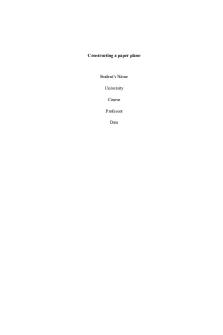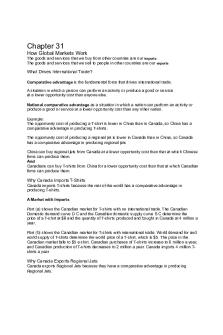3.1 Plane Problems PDF

| Title | 3.1 Plane Problems |
|---|---|
| Course | Engineering Mechanics |
| Institution | University of Auckland |
| Pages | 3 |
| File Size | 132 KB |
| File Type | |
| Total Downloads | 79 |
| Total Views | 163 |
Summary
Download 3.1 Plane Problems PDF
Description
Section 3.1
3.1 Plane Problems What follows is to be applicable to any two dimensional problem, so it is taken that σ yz = σ xz = 0 , which is true of both plane stress and plane strain.
3.1.1
Governing Equations for Plane Problems
To recall, the equations governing the elastostatic problem are the elastic stress-strain law (Part I, Eqns. 4.2.11-14), the strain-displacement relations (Eqns. 1.2.5) and the equations of equilibrium (1.1.10)
εxx =
1 +ν 1 1 σ xx − νσ yy , ε yy = σ yy −νσ xx , ε xy = σ xy E E E
[
]
[
Plane Stress
(3.1.1a)
1 +ν 1 +ν 1 +ν σ xy (1− ν )σ xx − νσ yy , ε yy = − νσ xx + (1 − ν )σ yy , ε xy = E E E σ zz = ν (σ xx + σ yy ) Plane Strain
(3.1.1b)
ε zz = − εxx =
]
[
ν E
(σ
]
ε xx = ε yy = ε xy
xx
+ σ yy )
[
]
∂u x ∂x ∂u y
∂y ∂u y 1 ⎛ ∂u = ⎜⎜ x + 2 ⎝ ∂y ∂x
Strain-displacement relations
(3.1.2)
Equations of Equilibrium
(3.1.3)
⎞ ⎟⎟ ⎠
∂σ xx ∂ σ xy + bx = 0 + ∂y ∂x ∂ σ yx ∂ σ yy + + by = 0 ∂x ∂y ∂σ zz + bz = 0 ∂z
One way of solving these equations is to re-write the stresses in 3.1.3 in terms of strains by using 3.1.1, and then using 3.1.2 to re-write the resulting equations in terms of displacements only. For example in the case of plane strain one arrives at
Solid Mechanics Part II
43
Kelly
Section 3.1
⎧⎪ ∂ 2 u x ∂2 u y ∂ 2 u ⎫⎪ + (1 − 2ν ) 2x ⎬ + b x = 0 ⎨ 2(1 − ν ) 2 + ∂x ∂x∂y ∂y ⎪⎭ ) ⎪⎩ ∂ 2 u y ∂2 u x ⎧⎪ ∂ 2 u y ⎫⎪ E + (1 − 2ν ) 2 ⎬ + b y = 0 ⎨2 (1 − ν ) 2 + 2 (1 +ν )(1 − 2ν ) ⎪⎩ ∂y ∂x∂y ∂x ⎪⎭
E 2 (1 +ν )(1 − 2ν
(3.1.4)
These are the 2D Navier’s equations, analogous to the 1D version, Eqn. 2.1.2. This set of partial differential equations can be solved subject to boundary conditions on the displacement. Obviously, in the absence of body forces, any linear displacement field satisfies 3.1.4, for example the field ux =
σo E
x + A − Cy,
uy = −
νσ o E
y + B + Cy
(3.1.5)
with A, B, C representing the possible rigid body motions; this corresponds to a simple tension σ xx = σ o . Solving Eqns. 3.1.4 directly for more complex cases is not an easy task. An alternative solution strategy for the plane elastostatic problem is the Airy stress function method described in the next section.
3.1.2
Problems
1. Derive the plane stress Navier equations analogous to 3.1.4. 2. Show that the displacement field u x = Ax2 , u y = −4 Axy /(1 + ν ) , in the absence of body forces, satisfies the plane stress governing equations derived in Problem 1 (this solution does not satisfy 3.1.4). Determine the corresponding stress field and verify that it satisfies the equilibrium equations. 3. Consider the thin plate shown below subjected to a uniform pressure p on the top and its own body weight. The plate is perfectly bonded to the base plate. (a) Does the stress distribution σ yy ( x, y ) = − p + ρg ( y − h), σ xx = σ xy = 0 satisfy the equations of equilibrium? (b) Does it satisfy the boundary conditions at the upper surface, and at the two free surfaces? (c) Suppose now that the plate was made out of elastic material. Show that, in that case, the stresses given above are actually not a correct solution to the problem.
Solid Mechanics Part II
44
Kelly
Section 3.1
p
h
y
Solid Mechanics Part II
x
45
Kelly...
Similar Free PDFs

3.1 Plane Problems
- 3 Pages

TEMA 31 - Apuntes 31
- 4 Pages

Appendixc 2 cartesian plane
- 7 Pages

Tutor hydro plane 1
- 7 Pages

Plane polarized light
- 5 Pages

FORCES IN PLANE TRUSS
- 8 Pages

Constructing a paper plane
- 4 Pages

Inclined Plane Lab
- 6 Pages

Test-bank-31 - Test-bank-31
- 14 Pages

Excercise 31
- 2 Pages

3.0 - Motion in a Plane
- 3 Pages

Prancha 31
- 1 Pages

Chapter 31
- 6 Pages
Popular Institutions
- Tinajero National High School - Annex
- Politeknik Caltex Riau
- Yokohama City University
- SGT University
- University of Al-Qadisiyah
- Divine Word College of Vigan
- Techniek College Rotterdam
- Universidade de Santiago
- Universiti Teknologi MARA Cawangan Johor Kampus Pasir Gudang
- Poltekkes Kemenkes Yogyakarta
- Baguio City National High School
- Colegio san marcos
- preparatoria uno
- Centro de Bachillerato Tecnológico Industrial y de Servicios No. 107
- Dalian Maritime University
- Quang Trung Secondary School
- Colegio Tecnológico en Informática
- Corporación Regional de Educación Superior
- Grupo CEDVA
- Dar Al Uloom University
- Centro de Estudios Preuniversitarios de la Universidad Nacional de Ingeniería
- 上智大学
- Aakash International School, Nuna Majara
- San Felipe Neri Catholic School
- Kang Chiao International School - New Taipei City
- Misamis Occidental National High School
- Institución Educativa Escuela Normal Juan Ladrilleros
- Kolehiyo ng Pantukan
- Batanes State College
- Instituto Continental
- Sekolah Menengah Kejuruan Kesehatan Kaltara (Tarakan)
- Colegio de La Inmaculada Concepcion - Cebu


